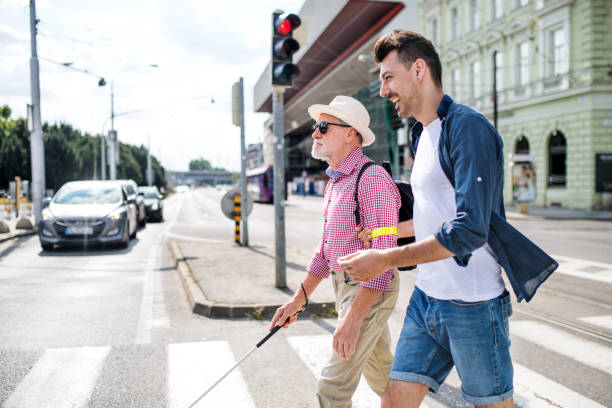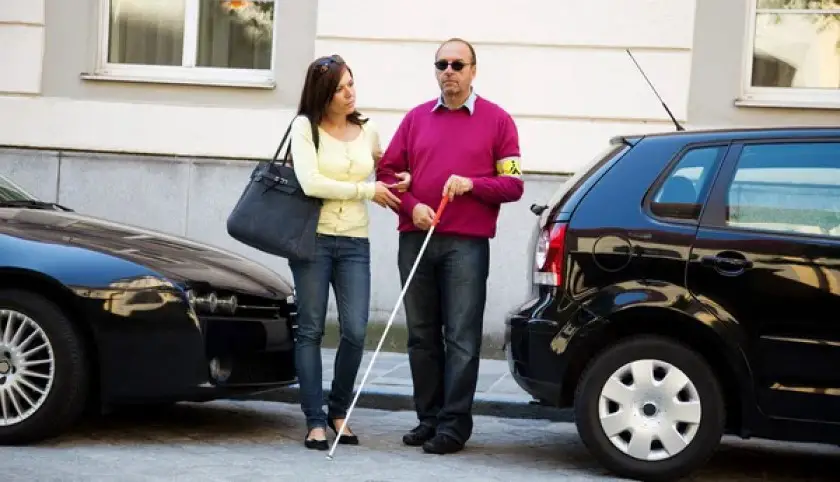For seeing people, getting directions to their desired location can be a question of simply checking their GPS.
They may also ask people for directions.
But for people with visual impairments, getting directions to their destinations of interest can be a bit trickier.
The reason for this is not far-fetched.
GPS maps and oral descriptions of routes have one thing in common; they are heavily landmark-based.
One can use conspicuous objects of natural or man-made origin such as hills, rocks, trees, houses, statues, or towers as the focal points of these descriptions.
Since blind people cannot see these landmarks, it is necessary to devise a unique means of giving them directions.
Table of Contents
Tips for Communicating with a Blind Person

Identify yourself
Be sure to introduce yourself before you initiate a conversation with a blind person.
Even if you’re a stranger who wishes to offer them help, it’s best to make a brief introductory statement to state your identity.
This helps to put the visually impaired persons at rest and helps them to trust you more easily.
Avoid making the blind person guess your identity, especially when you’re not on friendly terms or the visually impaired person requires urgent assistance.
Related: 5 Effective Ways Parents Punish a Blind Kid
Don’t shout
Blind people may not have their sight, but many of them hear as well as anybody else.
Be sure to avoid raising your voice higher than is necessary when communicating with persons with visual impairments. Shouting can cause them discomfort and apprehension.
Make your statements clearly and in your normal conversational tone, unless they request that you raise your voice.
Speak Directly
Address the blind person whom you wish to speak to by name when talking to them, especially when speaking in a group.
Be sure to announce your departure before leaving their company so as not to leave them talking to the thin air.
Don’t over patronize
While it is only natural to empathize with people with disabilities in general, it is important to avoid overdoing this.
Some people with disabilities get offended when they’re treated or spoken to condescendingly.
Be sure to speak to them in a respectful but non-patronizing tone when giving them directions and when communicating with them in general.
Related: How to Help a Blind Person Cross the Road
How to Give Directions to Blind People

Use the blind person as a reference point
Since visually impaired persons are unable to see landmarks, it is best to use their present positions as the reference point for your descriptions.
For instance, you can say, “You are currently standing adjacent to the administration building. Walk twenty steps forward until you reach the point where the road slopes downward”.
Or “You are currently on George Street, take a turn to your right and move on along that street until you get to the street corner”
This pattern of description is very vivid, clear, and allows the blind person to plan their movement effectively.
Avoid ambiguity
It is essential to give detailed descriptions when giving directions to blind people.
Avoid non-specific vague descriptions such as “over there”, “A bit far away from here”, “Quite far”, and so on. Instead, use detailed language such as “Ten paces from here”.
In addition, avoid descriptions that require vision to be perceived.
Don’t give descriptions such as “next to the big house” or “next to the red truck”.
Don’t point or make any other physical gestures or motions that cannot be perceived by them.
Describe sounds
Blind people often rely on their other senses (such as the sense of hearing) for direction. One can utilize sounds to give directions to a blind person.
Are there any spots with distinctive sounds such as water fountains, churches, schools, trees with singing birds on them, busy roads, and the likes on the way?
If yes, use any of these in giving the directions.
For instance, say “walk straight down the street until you hear the sounds of car horns intensify (at the street)”, “take a right turn at the point where you hear birds chirping (a tree)” or “take a left turn at the point where you hear rushing water (fountain)”.
Be sure to use sounds that are clear, distinct, and easy to remember.
Related: How a Blind Person Communicates with a Deaf Person
Describe feel
The sense of touch is one that disabled people often rely on to take cognizance of their environment.
Blind people can often easily note where the lush grass changes to hard concrete, where the road gets bumpier due to the presence of gravel, and where the soft sinking sand changes to flat tiles.
To utilize this, one may say “when you enter the tarred road, take a left turn” and “you know you are there when you feel tiles under your feet”.
Furthermore, road inclinations such as steep slopes or rising inclines certainly cannot escape the blind person’s notice. These can also be used as landmarks in giving them directions.
For instance, one may say “when you get to the downward sloping part of the road, you need to take a left turn”.
Describe smell
The sense of smell is perhaps even more powerful than that of sight. People can smell things so far away from them that they cannot even see them.
For blind persons, distinctive smells can be an important landmark. Some visually impaired persons can often distinguish between their close associates by the smell of their trademark perfumes.
Are there any locations along the route you wish to describe that have any unique smells?
These can range from the sweet scent of a flower garden or the delicious aroma of food from a food restaurant or bakery to the pungent odor oozing from a poorly managed waste disposal site.
Be sure to utilize any of these.
One may say, for example, “The house you seek is right next to the bakery from where you can smell freshly baked bread” or “when you begin to perceive the smell of barbecue, know that you are nearly there”.
It is preferable to use smells that can be easily perceived and spotted.
Point out danger spots
It is essential to remember that blind persons cannot see dangerous road features and objects.
It is, therefore, necessary to intimate them about the existence of these dangers and advise them on how to stay safe.
For instance, the road might have sharp bends, notoriously reckless traffic, or other dangers.
In this case, be sure to inform the blind person of where these threats are and how to avoid getting harmed by them. You may also suggest better and safer routes to take.




